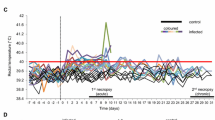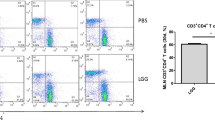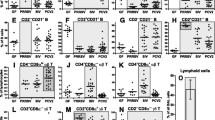Abstract
Purpose
Despite the high prevalence of respiratory diseases in the world and the extensive information available on the mucosal immune system, research on the development of the lung immune system in humans is limited by technical and ethical considerations; therefore, we studied the postnatal development of T lymphocytes in lung lobes in a porcine model.
Methods
Using less than 36-hour-old (NB), 1-week-weaned (5-week-old –AW-), 3-month-old (3M), and 4-year-old (4YR) healthy, nonvaccinated, specific pathogen free (SPF) Vietnamese miniature pigs, we studied the CD3+, CD4+, CD8+, TCR1 (gamma-delta T cells), and CD25+ (IL-2R-alpha) cell subpopulations in lung lobes parenchyma, bronchoalveolar lavage (BAL), peripheral blood mononuclear cells (PBMC), and cervical lymph nodes (LN) by flow cytometry.
Results
No differences among lung lobes were detected in any of the cell subpopulations tested. A low proportion of T cell subsets was detected in NB and 4YR groups in lung and BAL. Besides, the AW and 3M groups showed important changes in T cell subpopulations.
Conclusions
These results suggest that in healthy animals the lung lobes behave as a homogeneous immune organ. T cells were detected in very low percentages at birth and in adult life, which may explain the high susceptibility to respiratory infections both early and later in life. Postweaning antigenic challenges and endocrine and sexual maturity at 3M had important effects on the development of the mucosal immune system. It was also evident that changes at mucosal sites were poorly correlated with PBMC and LN.





Similar content being viewed by others
References
Marquez MG, Sosa GA, Roux ME (2000) Developmental study of immunocompetent cells in the bronchus-associated lymphoid tissue (BALT) from Wistar rats. Dev Comp Immunol 24:683
Lee N, Shin MS, Kang I (2012) T-cell biology in aging, with a focus on lung disease. J Gerontol A 67:254
Krejci J, Nechvatalova K, Blahutkova M, Faldyna M (2013) The respiratory tract in pigs and its immune system: a review. Vet Med 58(4):206–220
Spencer D, Yagan R, Blinkhorn R, Spagnuolo PJ (1990) Anterior segment upper lobe tuberculosis in the adult. Occurrence in primary and reactivation disease. Chest 97:384
Kim HC, Kim HS, Lee SJ, Jeong YY, Jeon KN, Lee JD, Hwang YS (2008) Endobronchial tuberculosis presenting as right middle lobe syndrome: clinical characteristics and bronchoscopic findings in 22 cases. Yonsei Med J 49:615
Westfall JA, Chatterjee A, Anderson NV (1994) Actinobacillus pleuropneumoniae in gnotobiotic piglets: ultrastructural changes in the pulmonary alveoli with dose and time. J Submicrosc Cytol Pathol 26:41
Balasubramanian V, Wiegeshaus EH, Taylor BT, Smith DW (1994) Pathogenesis of tuberculosis: pathway to apical localization. Tuber Lung Dis 75:168–178
Wiegeshaus E, Balasubramanian V, Smith D (1989) Immunity to tuberculosis from the perspective of pathogenesis. Infect Immun 57(12):3671–3676
Capuano S, Croix D, Pawar S, Zinovik A, Myers A, Lin P, Bissel S, Fuhrman C, Klein E, Flyn JA (2003) Experimental mycobacterium tuberculosis infection in cynomolgus macaques closely resembles the various manifestations of human M. tuberculosis infection. Infect Immun 71(19):5831–5844
Ling-Lin P, Pawar S, Myers A, Pegu A, Fuhrman C, Reinhart T, Capuano S, Klein E, Flynn JA (2006) Early events in mycobacterium tuberculosis infection in cynomolgus macaques. Infect Immun 74(7):3790–3803
Murai M, Krause P, Cheroutre H, Kronenberg M (2010) Regulatory T-cell stability and plasticity in mucosal and systemic immune systems. Mucosal Immunol 3:443
Kick AR, Tompkins MB, Flowers WL, Whisnant CS, Almond GW (2012) Effects of stress associated with weaning on the adaptive immune system in pigs. J Anim Sci 90:649
Shanley DP, Aw D, Manley NR, Palmer DB (2009) An evolutionary perspective on the mechanisms of immunosenescence. Trends Immunol 30:374
Hiller AS, Tschernig T, Kleemann WJ, Pabst R (1998) Bronchus-associated lymphoid tissue (BALT) and larynx-associated lymphoid tissue (LALT) are found at different frequencies in children, adolescents and adults. Scand J Immunol 47:159
Meurens F, Summerfield A, Nauwynck H, Saif L, Gerdts V (2012) The pig: a model for human infectious diseases. Trends Microbiol 20:50
Vega-Lopez MA, Telemo E, Bailey M, Stevens K, Stokes CR (1993) Immune cell distribution in the small intestine of the pig: immunohistological evidence for an organized compartmentalization in the lamina propria. Vet Immunol Immunopathol 37:49
Vega-Lopez MA, Bailey M, Telemo E, Stokes CR (1995) Effect of early weaning on the development of immune cells in the pig small intestine. Vet Immunol Immunopathol 44:319
Solano Aguilar GI, Beshah E, Vengroski KG, Zarlenga D, Jauregui L, Cosio M, Douglass LW, Dubey JP, Lunney JK (2001) Cytokine and lymphocyte profiles in miniature swine after oral infection with Toxoplasma gondii oocysts. Int J Parasitol 31:187
Vega-Lopez MA, Arenas-Contreras G, Bailey M, Gonzalez-Pozos S, Stokes CR, Ortega MG, Mondragon-Flores R (2001) Development of intraepithelial cells in the porcine small intestine. Dev Immunol 8:147
Sinkora J, Rehakova Z, Sinkora M, Cukrowska B, Tlaskalova-Hogenova H (2002) Early development of immune system in pigs. Vet Immunol Immunopathol 87:301
Sinkora M, Sinkora J, Rehakova Z, Butler JE (2000) Early ontogeny of thymocytes in pigs: sequential colonization of the thymus by T cell progenitors. J Immunol 165:1832
Talker SC, Kaser T, Reutner K, Sedlak C, Mair KH, Koinig H, Graage R, Viehmann M, Klingler E, Ladinig A, Ritzmann M, Saalmuller A, Gerner W (2013) Phenotypic maturation of porcine NK- and T-cell subsets. Dev Comp Immunol 40(1):51–68
Sinkora M, Butler JE (2009) The ontogeny of the porcine immune system. Dev Comp Immunol 33:273
Sinkora M, Sinkorova J, Holtmeier W (2005) Development of gammadelta thymocyte subsets during prenatal and postnatal ontogeny. Immunology 115:544
Tyan ML (1979) Development of immune competence. Mech Ageing Dev 9:79
Nakamura S, Suzuki M, Sugimoto A, Tsuji-Takayama K, Yamamoto M, Otani T, Inoue T, Harashima A, Okochi A, Motoda R, Yamasaki F, Orita K, Kibata M (2007) IL-2-independent generation of FOXP3(+)CD4(+)CD8(+)CD25(+) cytotoxic regulatory T cell lines from human umbilical cord blood. Exp Hematol 35:287
Adams B, Dubois A, Delbauve S, Debock I, Lhomme F, Goldman M, Flamand V (2011) Expansion of regulatory CD8+ CD25+ T cells after neonatal alloimmunization. Clin Exp Immunol 163:354
Parel Y, Chizzolini C (2004) CD4+ CD8+ double positive (DP) T cells in health and disease. Autoimmun Rev 3:215
Kasper M, Rudolf T, Hahn R, Peterson I, Müller M (1993) Immuno- and lectin histochemistry of epithelial subtypes and their changes in a radiation-induced lung fibrosis model of the mini pig. Histochemistry 100(5):367–377
Gheri G, Sgambati E, Bryk SG (2000) Glycoconjugate sugar residues in the chick embryo developing lung: a lectin histochemical study. J Morphol 243(3):257–264
Barkhordari A, Stoddart RW, McClure SF, McClure J (2004) Lectin histochemistry of normal human lung. J Mol Histol 35(2):147–156
Baba T, Iwasaki S, Maruoka T, Suzuki A, Tomaru U, Ikeda H, Yoshiki T, Kasahara M, Ishizu A (2008) Rat CD4+ CD8+ macrophages kill tumor cells through an NKG2D- and granzyme/perforin-dependent mechanism. J Immunol 180:2999
Taguchi T, Aicher WK, Fujihashi K, Yamamoto M, McGhee JR, Bluestone JA, Kiyono H (1991) Novel function for intestinal intraepithelial lymphocytes. Murine CD3+, gamma/delta TCR+ T cells produce IFN-gamma and IL-5. J Immunol 147:3736
Racanelli V, Leone P, Grakoui A (2011) A spatial view of the CD8+ T-cell response: the case of HCV. Rev Med Virol 21:347
Zuckermann FA (1999) Extrathymic CD4/CD8 double positive T cells. Vet Immunol Immunopathol 72:55
Pahar B, Lackner AA, Veazey RS (2006) Intestinal double-positive CD4+ CD8+ T cells are highly activated memory cells with an increased capacity to produce cytokines. Eur J Immunol 36:583
Tuchscherer M, Kanitz E, Puppe B, Tuchscherer A, Viergutz T (2009) Changes in endocrine and immune responses of neonatal pigs exposed to a psychosocial stressor. Res Vet Sci 87:380
Halle S, Dujardin HC, Bakocevic N, Fleige H, Danzer H, Willenzon S, Suezer Y, Hammerling G, Garbi N, Sutter G, Worbs T, Forster R (2009) Induced bronchus-associated lymphoid tissue serves as a general priming site for T cells and is maintained by dendritic cells. J Exp Med 206:2593
Blum KS, Pabst R (2007) Lymphocyte numbers and subsets in the human blood. Do they mirror the situation in all organs? Immunol Lett 108:45
Andreu-Ballester JC, Garcia-Ballesteros C, Benet-Campos C, Amigo V, Almela-Quilis A, Mayans J, Ballester F (2012) Values for alphabeta and gammadelta T-lymphocytes and CD4+, CD8+, and CD56+ subsets in healthy adult subjects: assessment by age and gender. Cytometry B 82:238
Trejdosiewicz LK, Smart CJ, Oakes DJ, Howdle PD, Malizia G, Campana D, Boylston AW (1989) Expression of T-cell receptors TcR1 (gamma/delta) and TcR2 (alpha/beta) in the human intestinal mucosa. Immunology 68:7
Yachie A, Ueno Y, Takano N, Miyawaki T, Taniguchi N (1989) Developmental changes of double-negative (CD3+ 4-8-) T cells in human peripheral blood. Clin Exp Immunol 76:258
Berndt A, Pieper J, Methner U (2006) Circulating gamma delta T cells in response to Salmonella enterica serovar enteritidis exposure in chickens. Infect Immun 74:3967
Ostroukhova M, Ray A (2005) CD25+ T cells and regulation of allergen-induced responses. Curr Allergy Asthma Rep 5:35
Hodge S, Hodge G, Flower R, Han P (2000) Surface and intracellular interleukin-2 receptor expression on various resting and activated populations involved in cell-mediated immunity in human peripheral blood. Scand J Immunol 51:67
Mizrahi M, Ilan Y (2009) The gut mucosa as a site for induction of regulatory T-cells. Curr Pharm Des 15:1191
D’Alessio FR, Tsushima K, Aggarwal NR, West EE, Willett MH, Britos MF, Pipeling MR, Brower RG, Tuder RM, McDyer JF, King LS (2009) CD4+ CD25+ Foxp3+ Tregs resolve experimental lung injury in mice and are present in humans with acute lung injury. J Clin Invest 119:2898
Ullrich R, Schieferdecker HL, Ziegler K, Riecken EO, Zeitz M (1990) Gamma delta T cells in the human intestine express surface markers of activation and are preferentially located in the epithelium. Cell Immunol 128:619
Mahic M, Henjum K, Yaqub S, Bjornbeth BA, Torgersen KM, Tasken K, Aandahl EM (2008) Generation of highly suppressive adaptive CD8(+)CD25(+)FOXP3(+) regulatory T cells by continuous antigen stimulation. Eur J Immunol 38:640
Pettersson FE, Schneider MK, Andersson J, Gronvik KO (2001) CD8+ T cells induce medullary thymic epithelium and CD4+ CD8+ CD25+ TCRbeta- thymocytes in SCID mice. Scand J Immunol 54:506
Silva-Campa E, Mata-Haro V, Mateu E, Hernandez J (2012) Porcine reproductive and respiratory syndrome virus induces CD4(+)CD8(+)CD25(+)Foxp3(+) regulatory T cells (Tregs). Virology 430:73
Tschernig T, Pabst R (2009) What is the clinical relevance of different lung compartments? BMC Pulm Med 9:39
Delespesse G, Yang LP, Ohshima Y, Demeure C, Shu U, Byun DG, Sarfati M (1998) Maturation of human neonatal CD4+ and CD8+ T lymphocytes into Th1/Th2 effectors. Vaccine 16:1415
Acknowledgments
We thank Dr. Mick Bailey and Dr. Karin Haverson (University of Bristol, UK) for providing monoclonal antibodies. Dr. L. Flores-Romo (CINVESTAV-IPN) and Dr. H. Wilson (U. Saskatchewan, Canada) critically read the manuscript. Thanks to Manuel Flores-Cano and Daniel Cortes-Casarrubias (UPEAL-CINVESTAV) for technical assistance.
Conflict of interest
The authors declared no conflict of interest.
Ethical Standards
All procedures followed institutional regulations (NOM-062-ZOO-1999), and the ad hoc Institutional Committee (CICUAL-CINVESTAV) authorized the experimental protocol.
Author information
Authors and Affiliations
Corresponding author
Rights and permissions
About this article
Cite this article
Balam-May, A.J., Ramírez-Estudillo, C., Lazo-Vázquez, G. et al. Postnatal Development of Lung T Lymphocytes in a Porcine Model. Lung 192, 793–802 (2014). https://doi.org/10.1007/s00408-014-9622-5
Received:
Accepted:
Published:
Issue Date:
DOI: https://doi.org/10.1007/s00408-014-9622-5




